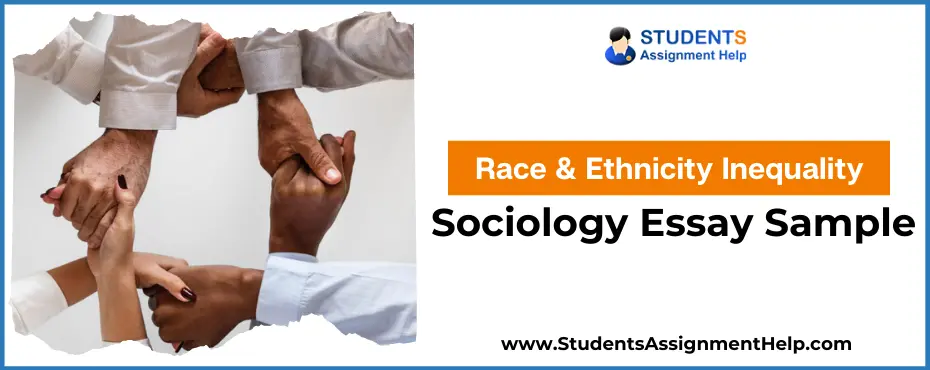Racial and Ethnic Inequality Sociology Essay Sample

Question
Write a 1,400-word essay by using sociological concepts and theories learned from lectures form that week on the topic:- racial or ethnic inequality. Write an essay to formulate core arguments and extend discussions. A suggested structure of the essay includes the following main sections:
• Introduction
• Literature review
• Main arguments
• Summary In writing your essay, you may consider the following questions to check whether you are on the right track (this is not exhaustive but a rough guideline)
Do you have a brief and clear introductory section?
[It introduces what topic you talk about, why you choose this topic, the significance of examining this topic, how you will construct your essay, and so on]
Do you provide informative and relevant literature review?
[This part may help you present the research background, showing what research has been done in this field, what are the major theoretical perspectives or core issues, whether there is any gap in existing research…]
Flexible Rates Compatible With Everyone’s Budget
Hire a Professional Essay & Assignment Writer for completing your Academic Assessments
Do you raise a research question clearly and construct your arguments well?
[The question should be based on your literature review and is expected to have theoretical significance or practical implication. To construct your arguments, you may use relevant concepts and theories from this subject as well as supportive materials from other sources. Do not extend your argument too broadly and without a focus…]
Do you have a summary and discussion of your study?
[What are your major viewpoints and findings? How well have you addressed your question? Do you have a conclusion? Does your study make any contribution and have any implication? Does it have any limitations…]
Introduction
Societies comprise of a variety of racial, cultural, and religious groups. In multiethnic societies, ethnic and racial diversity is apparent where ethnic conflict can be seen on existence on a continual basis for many generations. Today, only a few member countries out of more than 180 member nations of the United Nations are ethnically homogenous. Sociologists regard multi-ethnicity as the rule.
Furthermore, the extent of such ethnic diversity is very large and even the largest group in such societies does not constitute even half of the overall population of that society. Racism has emerged as the major issue in multiethnic societies (Platt 2011).
The research identifies the presence, effect and influence of racism in multiethnic societies whether multiethnic society has increased racism and how it affects ethnic minority groups.
Literature review
Bailey, Loveman, and Muniz (2012) identify racial disparities in earnings of black people when compared to those classified as brown. As per the social constructionist theory, the term ‘race’ is regarded as the contextual and multidimensional social construct. A number of factors give way to the meaning of racial identification, such as self-perception, interactional cues, prevailing cultural understandings, and perception of others (Bailey, Loveman, and Muniz 2012). Ostine (2013) and Jarrett (2000) present the racial barriers that add a dimension to routine problems faced by immigrants in the US society.
For Haitian immigrants in the US, colour of the skin suddenly becomes a major issue, and it is such an issue that the members of the race cannot overcome (Ostine 2013; Jarrett 2000).
Platt (2011) highlights inequality within the ethnic groups of the society. Implications of inequality within ethnic groups cannot be ignored for addressing the poverty of ethnic minority groups.
Poverty and inequality tend to be interlinked even if they are distinct at the theoretical level. Presence of greater inequality is also the implication of heterogeneity among those who are designated as poor (Platt 2011).
Social scientists had maintained for many years that industrialization as well as the forces of modernization would play a role in diminishing the importance of race and ethnicity in heterogeneous societies. Social scientists felt that with the phenomenon of breakdown of small and particular social units, and the following emergence of large, impersonals institutions of bureaucracy, the loyalty and identity of people would be directed to the national state and identity. They had the notion that national identity would supersede the identity of belongingness to internal racial and ethnic communities (Marger 2006).
However, the contemporary world witnesses the opposite trend. In past several decades, various ethnic groups that were considered to be well absorbed in the national society have rejuvenated their cultural identity. In multiethnic societies, ethnic relations usually take the form of high competition and conflict. Popular media accounts of ethnic relations in countries such as the US and UK are generally the descriptions of violence and hostility.
However, conflicts at intergroup level in multiethnic societies are not always observed. Discord and strife are not always the key characteristic of races in multiethnic societies. Accommodation and cooperation are also the characterization of ethnic relations (Bertrand and Haklai 2013; Jarrett 2000).
However, various ethnic groups are treated as per the ranking system of the groups in the multiethnic society as a result of which they get unequal amounts of valued resources of society- prestige, power, and wealth. Institutions automatically favour dominant groups, while the other ethnic groups, named as minorities remain in lower positions (Coretta 2011).
Booth, Leigh and Varganova (2010) study the variations of racial and ethnic discrimination across minority groups in Australia.
They suggest that some minority groups suffer extreme forms of persecution both in the public places and at work. As per the conflict theories of race and ethnic stratification, the major reason of discrimination and racism is group conflict. The split labour perspective shows that occupational competition leads between new and old immigrants show leads to the outcome of ethnic hostilities and following division of the working class. Dominant classes or races are benefitted due to more access to the resources of the society (Booth, Leigh and Varganova 2010).
NASP (National Association of School Psychologists) position statement regarding racism, prejudice and discrimination also sheds a light on the discriminatory treatment of people against minority (Racism, Prejudice and Discrimination 2013). When racial inequalities are present in a society, it becomes difficult for racially subordinate groups to learn and thrive.
For example, individuals belonging to historically marginalized racial groups may be regarded as less worthy or less intellectual or intelligent from those members belonging to the majority culture. In contrast to children and communities of minority culture, children or communities from the majority culture are allowed to maintain their valued status as well as established privileges.
Provision of such privilege can have the outcomes in the form of better treatment and opportunities that others can afford within the system of education and other social institutions (Racism, Prejudice and Discrimination 2013).
The presence of racism harms everyone in the society, but it has the most negative and everlasting impact on individuals belonging to racial minority groups. Racial prejudice is the attitude or orientation of a particular group about the position of different types of racial groups existing within the social order. People from both majority and minority groups can adopt such attitudes of racial prejudice. Racial discrimination is adopted by the majority group in the form of overt or subtle actions, which leads to limitation of the opportunities for the minority group in the field of economy, society, politics and education. Stress related to discrimination has a direct association with depression.
Stereotypes related to races become self-fulfilling prophecy that result in negative outcomes for the members of the multi-ethnic society (Racism, Prejudice and Discrimination 2013; Dustman and Theodoropoulos 2013).
Karlsen and Nazroo (2002) made an effort to explore the relationship between social class, racism, and health among people belonging to ethnic minority in England and Wales.
The research concluded that varying ways in which racism can manifest itself like institutional discrimination, interpersonal violence, or socioeconomic disadvantage have independent derogatory effects on health irrespective of the health indicator used. Authors find out that the physical and mental health consequences of an assault that is racially motivated may be different from those consequences associated with the generally more subtle racism that people experience in their daily lives (Karlsen and Nazroo 2002).
Arguments
Ethnic minority groups are the result of stratification and ranking system in multiethnic societies of the world. From the review of literature, it can be argued that racism and ethnic inequalities contribute to depression, stress and various other negative consequences for those who occupy the lower status in the social order (Karlsen and Nazroo 2002; Platt 2011; Coretta 2011).
As identified from the literature review, sociologists earlier thought that industrialization and capitalization would result in national identity rather than the inter-group identity. However, reverse has happened and all ethnic groups existing in multi-ethnic societies have reemphasized their cultural identity.
The dominant groups in the society have access to all resources and facilities available, while the ethnic minority groups face the prejudice and discrimination in terms of automatic assumptions of the society stratification and order. They are considered less intelligent or intellectual. Institutional systems such as education field have not remained unaffected by such racial discrimination. Health has come out to be another highly noticeable consequence of ethnic inequalities and their effects on ethnic minorities in the society (Karlsen and Nazroo 2002).
Researchers have shown that discriminatory policies are entwined within the organizational structures. People belonging to ethnic minority groups have lower incomes and they are generally concentrated in geographic areas that are poor in terms of economy and environment (Platt 2011; Karlsen and Nagroo 2002). Although wide documentation of the relationship between health and social position is present in sociology research, little evidence is present on the level to which ethnic concentration of disadvantage is the outcome of institutional racism.
Poverty and racial discrimination are also found to be interlinked in the literature review. However, as mentioned by Karlsen and Nagroo (2002), authors such as Nandi and Platt (2010), Brewer et al (2009) and Hills et al (2010) present the question that if income inequalities between groups matter, they might influence the overall inequality in the society. Nevertheless, inequality between groups makes a significantly less contribution to overall inequality.
Conclusion
It can be concluded from the research that differences and discrimination exist for ethnic minority group in a multi-ethnic society. Dominant ethnic groups tend to have comparatively large access to the resources of the society, while individuals belonging to minorities and facing racial discrimination have to face negative consequences in terms of limited access to resources and opportunities in the society overall.
The limitation exists in terms of studying the question in the general context. Study of a specific society with further deep study of relationship existing between societal factors, such as poverty and health, and their relation to racial discrimination can further enhance the knowledge on the topic.
References
Bailey, S.R., Loveman, M. and Muniz, J.O. 2012. Measures of ‘‘Race’’ and the analysis of racial inequality in Brazil. Social Science Research, 13.
Bertrand, J. and Haklai, O. 2013. Democratization and Ethnic Minorities: Conflict or compromise. London: Routledge.
Booth, A., Leigh, A. and Varganova, E. 2010. Does Racial and Ethnic Discrimination Vary Across Minority Groups? Evidence from a Field Experiment. [Online]. Available at: https://ftp.iza.org/dp4947.pdf [Accessed on: 14 October 2014].
Coretta, P. 2011. Institutional racism and ethnic inequalities: an expanded multilevel framework. Journal of social policy, 40 (01), 173-192.
Dustman, C. and Theodoropoulos, N. 2013. [Online]. Available at: https://www.ucl.ac.uk/~uctpb21/Cpapers/SubmissionOEP_June.pdf [Accessed on: 14 October 2014].
Jarrett, A.A. 2000. The Impact of Macro Social Systems on Ethnic Minorities in the United States. USA: Greenwood Publishing Group.
Karlsen, S. and Nazroo, J.Y. 2002. Relation Between Racial Discrimination, Social Class, and Health Among Ethnic Minority Groups. Am J Public Health, 92(4), 624–631.
Marger, M.N. 2006. Race and Ethnic Relations: American and Global Perspectives. USA: Thomson Learning, Inc.
Ostine, R. 2013. Caribbean Immigrants and the Sociology of Race and Ethnicity: Limits of the Assimilation Perspective. [Online]. Available at: https://www.rcgd.isr.umich.edu/prba/perspectives/spring1998/rostine.pdf [Accessed on: 14 October 2014].
Platt, L. 2011. Inequality within ethnic groups. [Online]. Available at: https://www.jrf.org.uk/sites/files/jrf/inequality-ethnicity-poverty-full.pdf [Accessed on: 14 October 2014].
Racism, Prejudice and Discrimination. 2013. [Online]. Available at: https://www.nasponline.org/about_nasp/positionpapers/RacismPrejudice.pdf [Accessed on: 14 October 2014].





